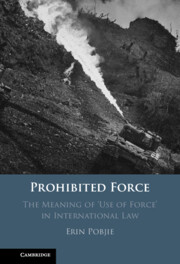Despite the central importance of this provision in the international legal order, there remains genuine uncertainty among States, scholars and jurists about the meaning of a prohibited ‘use of force’ under article 2(4) of the UN Charter and customary international law.
It is difficult to disagree with this starting point of Dr Erin Pobjie’s analysis if one only considers the present uncertainty about the right answers to be given to questions such as whether the use of force within the meaning of the prohibition must pass a certain gravity threshold, whether such a use of force presupposes a physical effect or at least the potential of a physical effect, what level of directness between the means employed and the (potential physical) effects is required, whether there is a need to distinguish the use of force within the meaning of the prohibition from forcible police measures or whether the term ‘use of force’ implies an element of intentionality. This state of affairs leaves much to be desired not only because the prohibition of the use of force, in the words of the International Court of Justice, constitutes a ‘cornerstone of the United Nations Charter’ but also because of the fact that the existence of a use of force entails distinct legal consequences. Hence, one cannot but agree with the author’s conviction that ‘for such a foundational rule of the international legal system, it is not satisfactory to apply vague, ad hoc standards’ to determine whether or not potentially forcible incidents fall within the scope of the prohibition of the use of force. Dr Pobjie is therefore to be commended for having produced a book which applies both impressive doctrinal rigour and remarkable intellectual creativity to the clarification of the meaning of a core concept of the existing international legal order. In my humble view, the central contribution of this elegantly written study consists of the suggestion to treat the term ‘use of force’ as a type rather than a concept and to identify a basket of elements which, while not all having to be present, must be weighed and balanced to determine whether the threshold for the definition is met. It is by no means a weakness, but it rather testifies to the author’s unfailing scholarly spirit that she does not pretend to be able to apply her innovative approach to all conceivable questions of delineation in a work that she has thankfully kept to an accessible size. Instead, the author has carefully chosen a number of illustrative case studies in order to demonstrate by way of examples the work her new methodology is capable of doing. Apart from making for enjoyable and stimulating reading, these practical applications put the author’s approach to the reader’s test in all due concreteness and transparency. Dr Pobjie does not make the bold assertion that the use of her methodology will yield incontrovertible results in all possible instances. More modestly, but probably more realistically, she claims that it provides a shared language and coherent framework for legal analysis and scholarly debate regarding the content of a prohibited ‘use of force’ between States under international law. In that vein, her thoughtfully worded conclusion reads as follows:
The framework of type theory has the potential to facilitate clearer analysis of ‘uses of force’ between States. It is hoped that this clarity will in turn lead to greater compliance with the prohibition of the use of force between States in their international relations and contribute to our shared endeavour of international peace and security.
Such new potential would indeed constitute a significant advance in strengthening the international legal order in one of its core components. For this reason alone, Erin Pobjie’s book deserves the closest attention of international lawyers worldwide. At the very least, Prohibited Force: The Meaning of ‘Use of Force’ in International Law will move the conversation about the prohibition of the use of force to a higher level of analytical clarity. This is no small achievement.

